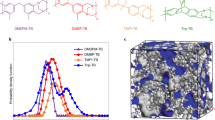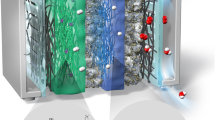Abstract
Proton exchange membrane fuel cells have the potential for applications in energy conversion and energy storage, but their development has been impeded by problems with the membrane electrode assembly. Here, we demonstrate that a silicon-based inorganic–organic membrane offers a number of advantages over Nafion—the membrane widely used as a proton exchange membrane in hydrogen fuel cells—including higher proton conductivity, a lack of volumetric size change, and membrane electrode assembly construction capabilities. Key to achieving these advantages is fabricating a silicon membrane with pores with diameters of ∼5–7 nm, adding a self-assembled molecular monolayer on the pore surface, and then capping the pores with a layer of porous silica. The silica layer reduces the diameter of the pores and ensures their hydration, resulting in a proton conductivity that is two to three orders of magnitude higher than that of Nafion at low humidity. A membrane electrode assembly constructed with this proton exchange membrane delivered an order of magnitude higher power density than that achieved previously with a dry hydrogen feed and an air-breathing cathode.
This is a preview of subscription content, access via your institution
Access options
Subscribe to this journal
Receive 12 print issues and online access
$259.00 per year
only $21.58 per issue
Buy this article
- Purchase on Springer Link
- Instant access to full article PDF
Prices may be subject to local taxes which are calculated during checkout






Similar content being viewed by others
References
Gold, S., Chu, K.-L., Lu, C., Shannon, M. A. & Masel, R. I. Acid loaded porous silicon as a proton exchange membrane for micro-fuel cells. J. Power Sources 135, 198–203 (2004).
Pichonat, T. & Gauthier-Manuel, B. Realization of porous silicon based miniature fuel cells. J. Power Sources 154, 198–201 (2006).
Devanathan, R. Recent developments in proton exchange membranes for fuel cells. Energy Environ. Sci. 1, 101–119 (2008).
Athens, G. L., Ein-Eli, Y. & Chmelka, B. F. Acid-functionalized mesostructured aluminosilica for hydrophilic proton conduction membranes. Adv. Mater. 19, 2580–2587 (2007).
Lehmann, V. Electrochemistry of Silicon: Instrumentation, Science, Materials and Applications (Wiley-VCH, 2002).
Föll, H., Carstensen, J. & Frey, S. Porous and nanoporous semiconductors and emerging applications. J. Nanomater. 2006, 1–10 (2006).
Glass, J. A., Wovchko, E. A. & Yates, J. T. Reaction of atomic hydrogen with hydrogenated porous silicon-detection of precursor to silane formation. Surf. Sci. 348, 325–334 (1996).
Silberzan, P., Leger, L., Ausserre, D. & Benattar, J. J. Silanation of silica surfaces. A new method of constructing pure or mixed monolayers. Langmuir 7, 1647–1651 (1991).
Tripp, C. P. & Hair, M. L. An infrared study of the reaction of octadecyltrichlorosilane with silica. Langmuir 8, 1120–1126 (1992).
Le Grange, J. D., Markham, J. L. & Kurkjian, C. R. Effects of surface hydration on the deposition of silane monolayers on silica. Langmuir 9, 1749–1753 (1993).
Tripp, C. P. & Hair, M. L. Direct observation of the surface bonds between self-assembled monolayers of octadecyltrichlorosilane and silica surfaces: a low-frequency IR study at the solid/liquid interface. Langmuir 11, 1215–1219 (1995).
Onclin, S., Ravoo, B. J. & Reinhoudt, D. N. Engineering silicon oxide surfaces using self-assembled monolayers. Angew. Chem. Int. Ed. 44, 6282–6304 (2005).
Gupta, P., Colvin, V. L. & George, S. M. Hydrogen desorption kinetics from monohydride and dihydride species on silicon surfaces. Phys. Rev. B 37, 8234–8243 (1988).
Halimaoui, A., Campidelli, Y., Larre, A. & Bensahel, D. Thermally induced modifications in the porous silicon properties. Phys. Status Solidi 190, 35–40 (1995).
Sugiyama, H. & Nittono, O. Microstructure and lattice distortion of anodized porous silicon layers. J. Crystal Growth 103, 156–163 (1990).
Herino, R., Perio, A., Barla, K. & Bomchil, G. Microstructure of porous silicon and its evolution with temperature. Mater. Lett. 2, 519–523 (1984).
Labunova, V., Bondarenkoa, V., Glinenkoa, I., Dorofeeva, A. & Tabulinaa, L. Heat treatment effect on porous silicon. Thin Solid Films 137, 123–134 (1986).
Gupta, P., Dillon, A. C., Bracker, A. S. & George, S. M. FTIR studies of H2O and D2O decomposition on porous silicon surfaces. Surf. Sci. 245, 360–372 (1991).
Ogata, Y., Niki, H., Sakka, T. & Iwasaki, M. Oxidation of porous silicon under water vapor environment. J. Electrochem. Soc. 142, 1595–1601 (1995).
Gorbanyuk, T. I., Evtukh, A. A., Litovchenko, V. G., Solnsev, V. S. & Pakhlov, E. M. Porous silicon microstructure and composition characterization depending on the formation conditions. Thin Solid Films 495, 134–138 (2006).
Iler, R. K. The Chemistry of Silica (Wiley, 1976).
Brinker, C. J. & Scherer, G. W. Sol–Gel Science: The Physics and Chemistry of Sol–Gel Processing (Academic Press, 1990).
Jiang, Y.-B. et al. Sub-10-nm-thick microporous membranes made by plasma-defined atomic layer deposition of a bridged silsesquioxane precursor. J. Am. Chem. Soc. 129, 15446–15447 (2007).
Sone, Y., Ekdunge, P. & Simonsson, D. Proton conductivity of Nafion 117 as measured by a four-electrode AC impedance method. J. Electrochem. Soc. 143, 1254–1259 (1996).
Zawodzinski, T. A. et al. A comparative study of water uptake by and transport through ionomeric fuel cell membranes. J. Electrochem. Soc. 140, 1981–1985 (1993).
Sumner, J. J., Creager, S. E., Ma, J. J. & DesMarteau, D. D. Proton conductivity in Nafion 117 and in a novel bis[(perfluoroalkyl)sulfonyl]imide ionomer membrane. J. Electrochem. Soc. 145, 107–110 (1998).
Lucovsky, G., Yang, J., Chao, S. S., Tyler, J. E. & Czubatyj, W. Oxygen-bonding environments in glow-discharge-deposited amorphous silicon–hydrogen alloy films. Phys. Rev. B 28, 3225–3233 (1983).
Uchino, T., Sakka, T. & Iwasaki, M. Interpretation of hydrated states of sodium silicate glasses by infrared and Raman analysis. J. Am. Ceram. Soc. 74, 306–313 (1991).
Hagymassy, J., Brunauer, S. & Mikhail, R. S. Pore structure analysis by water vapor adsorption. I. t-curves for water vapor. J. Colloid Interface Sci. 29, 485–491 (1969).
Moghaddam, S., Pengwang, E., Lin, K. Y., Masel, R. I. & Shannon, M. A. Millimeter-scale fuel cell with onboard fuel and passive control system. J. MEMS 17, 1388–1395 (2008).
Acknowledgements
Financial support for the UIUC team was provided by the Defense Advanced Research Projects Agency (DARPA). C.J.B. was supported through the US Department of Energy, Office of Basic Energy Sciences (grant DE-FG02-02-ER15368) and, Division of Catalysis and Division of Materials Sciences and Engineering. Y.B.J. was supported through the Sandia National Laboratories LDRD program. This work was carried out in part in the Frederick Seitz Materials Research Laboratory Central Facilities, University of Illinois, which are partially supported by the US Department of Energy under grant nos DE-FG02-07ER46453 and DE-FG02-07ER46471. The authors would like to thank T. Spila, R. Haasch and V.V. Mainz for their assistance with the ToF–SIMS, XPS and NMR analysis, and G. Mensing for reviewing the paper. The help of R. Morgan and J. Jihyung in preparing catalysts is also appreciated.
Author information
Authors and Affiliations
Contributions
S.M. conceived the asymmetric PEM and MEA designs and conceived and performed the self-terminating pore fabrication process as well as modification of the pore surface properties. S.M. performed characterization tests and data analysis. S.M. and M.A.S. discussed the results. E.P. KOH-etched the silicon membranes and deposited the chromium/gold layers. Y.B.J. and C.J.B. performed the PD–ALD work and wrote the corresponding section in the paper. A.R.G. and D.J.B. conducted water desorption tests on some of the membranes. S.M. wrote the paper. M.A.S., C.J.B. and R.I.M commented on the paper.
Corresponding authors
Ethics declarations
Competing interests
The authors declare no competing financial interests.
Supplementary information
Supplementary information
Supplementary information (PDF 717 kb)
Rights and permissions
About this article
Cite this article
Moghaddam, S., Pengwang, E., Jiang, YB. et al. An inorganic–organic proton exchange membrane for fuel cells with a controlled nanoscale pore structure. Nature Nanotech 5, 230–236 (2010). https://doi.org/10.1038/nnano.2010.13
Received:
Accepted:
Published:
Issue Date:
DOI: https://doi.org/10.1038/nnano.2010.13
This article is cited by
-
Rational design of robust iridium-ceria oxide-carbon nanofibers to boost oxygen evolution reaction in both alkaline and acidic media
Nano Research (2023)
-
Local structure engineering for active sites in fuel cell electrocatalysts
Science China Chemistry (2020)
-
Visualizing pore architecture and molecular transport boundaries in catalyst bodies with fluorescent nanoprobes
Nature Chemistry (2019)
-
Nitrogen-Mediated Graphene Oxide Enables Highly Efficient Proton Transfer
Scientific Reports (2017)
-
Nanocrack-regulated self-humidifying membranes
Nature (2016)



